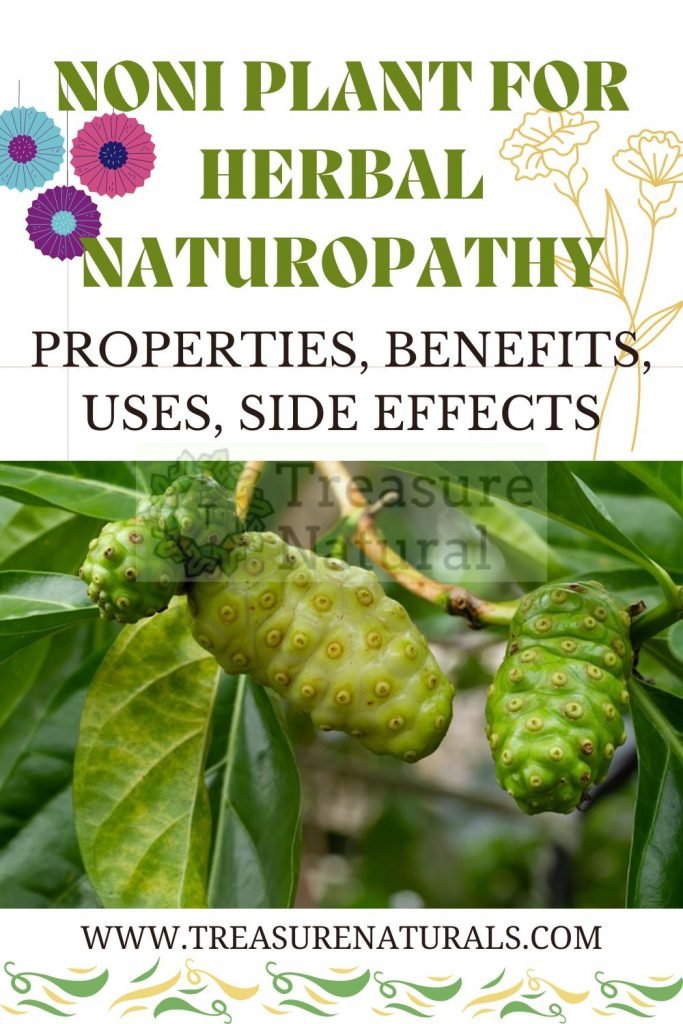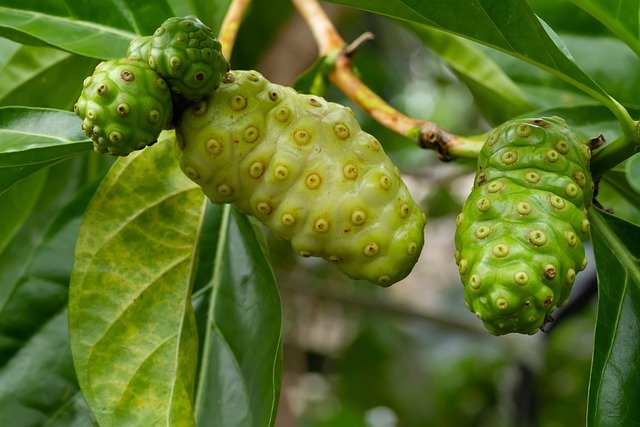
The exotic plant of Noni( Morinda citrifolia ) has been known for millennia in the Polynesian islands for its beneficial properties and, currently, it is of interest to studies for the various therapeutic activities attributable to it. Let’s find out better.
Property of Noni
Many of the properties of Noni are attributable to the enzyme xeronine, an important component of the cell membrane that exerts a regenerative and repairing action on damaged cells and regulates the function of proteins.
The juice gives energy and fights weakness, because the enzymes contained in it favor the assimilation of amino acids, vitamins and mineral salts. Noni also stimulates the secretion of endorphins and serotonin, improving mental efficiency and mood. Noni also has the following properties:
- It produces unique pain relieving and anti- inflammatory effects.
- Regulates cellular function and cell regeneration of damaged cells.
- Eliminates and fights against many types of bacteria, such as E. Coli.
- It stimulates the production of T cells in the immune system (T cells play a key role in defeating and annihilating disease).
- It inhibits the growth of tumors.
- It has adaptogenic properties.
The most important constituents of Noni are:
- Vitamins and minerals : Noni is rich in vitamins A and C, essential for our body, as they are both involved in numerous biochemical activities. In particular, the juice is a good source of vitamin C (or ascorbic acid), which is important for the immune system and for its antioxidant action. Additionally, Noni fruit contains minerals such as magnesium, iron, potassium, selenium, zinc, calcium, sodium, copper, and sulfur.
- Proxeronine and xeronine : Proxeronine is an alkaloid and is a precursor of xeronine. The latter substance is involved in a large number of biochemical processes and appears to take part in the metabolism of proteins. Furthermore, it promotes the intestinal absorption of minerals, amino acids and vitamins, taken with food.
- Coumarins : are natural substances with anticoagulant, phlebotonic, antispasmodic and antibacterial functions. Scopoletin is one of the main coumarins present. This has been shown to have hepatoprotective activity and an adaptogenic effect. Scopoletin protects the cardiovascular system, normalizes blood pressure, exerts an anti-inflammatory and antihistamine action.
- Terpenes and terpenoids : terpenes perform an antioxidant action by counteracting free radicals. In Noni there are: eugenol (antiseptic and anesthetic), beta-carotene (precursor of vitamin A) and ursolic acid. Terpenoids are compounds related to terpenes and possess important antioxidant properties.
- Polysaccharides (glucuronic acid, arabinose, galactose) : they are polymers made up of monosaccharides that can act as immunostimulants.
- Serotonin : is a neurotransmitter that plays an important role in the regulation of mood, sleep-wake rhythm, the stimulation of hunger and thermoregulation at the level of the central nervous system. Serotonin affects the perception of pain and stimulates the biosynthesis of melatonin. Finally, the synergistic effect of scopoletin, serotonin and xeronine is also able to stabilize the blood glucose values.
- Damnacanthal : is an alkaloid that increases the immune defenses by stimulating the production of macrophages and appears to have an inhibitory action on some pre-cancer cells.
- Other important phytochemicals contained in Noni are: antioxidants, deacetylasperulosidic acid, niacin (vitamin B3), carotenes, linoleic acid, caprylic and caproic acid, anthraquinones, flavonglycosides, alkaloids, beta-sitosterol, flavonoids, catechins, amino acids, proteins, carbohydrates, fiber, fructose.
All these elements help to improve and enhance the performance of our immune system and also it must be considered that they confer many other properties such as analgesic, sedative and anti-inflammatory type.
How to use
The use of Noni is particularly suitable for supporting particularly tiring moments associated with stress, improving concentration and mood. The juice is the most common Morinda citrifolia derivative on the market. The one on the market does not consist exclusively of “100% pure” fruit.
Generally speaking, the derivative of Noni is mixed with the juices of other fruits (such as blueberries, apples and grapes), in order to improve the flavor which, by nature, has an acidic taste and an unpleasant smell. The juice should be taken on an empty stomach to avoid any interference with other foods. After drinking Noni, it is important to wait at least half an hour before eating, as digestion can compromise the absorption of the active ingredients contained in the juice.
As for the dosage, it is preferable to follow the instructions provided by the manufacturer, on the package (usually two tablespoons of juice a day are enough). It is not recommended to take Noni juice together with milk , coffee, tea or alcohol, because these drinks risk limiting the correct absorption of the substances contained in Noni by the body. Generally, it is advisable not to combine it even with tobacco smoke and guarana, to avoid excessive stress on the metabolism .
To obtain a beneficial effect it is essential to consume Noni juice regularly and continuously (for at least a month). Noni juice is a recently popular product and is being sold as a dietary or nutritional supplement. Anyone who wants can integrate noni juice into their diet, but not before having had a consultation with the general practitioner, especially for those cases that include ordinary use of other prescribed drugs.
Noni leaves are also used as food for pets and silkworms (India). In Puerto Rico, the fruits are used as food for pigs . The Noni bark contains a red pigment and the roots contain a yellow pigment; both are used, with lower yields than other species of the genus Morinda , for the production of dyes for fabrics and leathers. The wood is used, like the wood of other tree species, for construction, firewood, sculptures, etc. An insect repellent oil is obtained from the seeds.
Contraindications of Noni
There are no formally ascertained side effects and the product is to be considered safe, if the indicated doses are respected. During the first assumptions, Noni juice could cause feelings of discomfort in the stomach and digestive system, in some particularly sensitive subjects. This type of disorder usually clears up within the first two weeks of taking.
Noni juice has a good potassium content and should be avoided for those suffering from kidney failure.
Taking certain medicines in combination with Noni may produce a moderate interaction and therefore requires attention. It is advisable not to use noni juice during pregnancy or breastfeeding, in children or in people with liver or kidney disease. Furthermore, it must be remembered that the natural product has a strong energizing action, which can cause some people to have an exciting effect.
Excessive noni dosage could lead to intestinal difficulties with laxative effects, such as diarrhea, stomach bloating or other intestinal problems which should subside quickly. Other side effects, again in case of overdose, could be linked to breathing difficulties and allergic reactions. In any case of discomfort, it is advisable to stop taking noni immediately and to consult your doctor for investigations.
Description of the plant
Noni ( Morinda citrifolia ) is a plant belonging to the Rubiaceae family. It is also known as Indian mulberry, nonu, nono, bumbo, lada, munja, and Canary wood. The noni is a small evergreen tree, usually with a height of between 3 and 6 m (exceptionally up to 10).
The leaves are elliptical or ovate and rather large (20 to 45 cm). The flowers have 5 petals (even 6) and are gathered in globose inflorescences. What is called fruit is actually a syncarp , that is the fusion of many small fruits into a single mass (as happens with mulberry blackberries). Noni is one of the few plants that produces flowers in the presence of the fruit and produces fruit all year round.
When ripe, the fruit of Noni is 5-10 cm long, is tender and has an unpleasant odor, which brings to mind the smell of mature cheese. It is believed that the spread of Noni in a wide geographical area is due to the peculiarity of the seeds which, equipped with an air pocket, can float on water for months remaining vital and, carried by currents, can travel great distances. The roots have a strong ability to expand laterally.
The habitat of the Noni
Noni is native to Southeast Asia, tropical and warm-temperate, from India to Taiwan and up to northern Australia . The species went wild in other areas where it was brought by man. It can be grown on all types of soils, acidic, neutral or alkaline, and also resists high salt concentrations, so it can be found near beaches.
It bears sunny and shady exposures and arid or humid climates. The largest cultivation center is Polynesia, in particular Tahiti.
Background

Traditionally in Hawaiian and Polynesian cultures the plant was considered sacred and was revered as a source of life. The indigenous kahuna healers, who used native herbs and plants, called it the ” tree of life “, “plant that kills pain” and also “tree of headache”. All parts of Noni (bark, roots, leaves, flowers and fruits) have been used in herbal medicine for their medicinal properties.
The Noni plant has been used for more than 1,500 years by indigenous Polynesians as the most important health remedy. For more than 2,000 years Polynesian healers have made use of the leaves, roots, barks, flowers and fruits of Nonu in order to prepare effective remedies for the hundreds of health-threatening diseases. Nonu is considered the “sacred plant “.
Traditionally, the indigenous healers of Polynesia prepared a juice using the ripe fruits that were left to ferment in the sun for long periods. Even today the companies that have started the international business around the Noni phenomenon follow the ancient and traditional method of fermentation.






